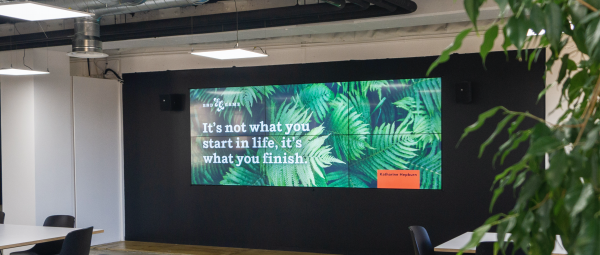Stones
We’re big fans of Scaling Up by Verne Harnish. Scaling Up is a toolbox for growing a business and one of the tools Verne suggests is a quarterly theme — a great way to focus the company on a single KPI for three months, then celebrate when you achieve it.
We don’t do themes every quarter, but some of the themes we have done include destroying the Death Star, Reducing Waste and Space Invaders (yes, client work was represented as aliens).
This quarter, we wanted to focus on giving us and our partners better clarity of the work we are doing. In my last post, I showed how we break work down into goals and objectives. What we were seeing through, was objectives and goals running together and people losing sight of the big picture, ‘the why’, because we were lost in the detail and pace of constant sprints and releases.
Another tool from Scaling Up is the one-page strategic plan. There is a box on this plan called “profit per X”. The question is: what is X in our business? X represents an economic unit that is profitable, so delivering more of these will result in growing the business. For a services business, should X represent an hour, a software release, a client, or a project?
After some debate, mostly around our core value of, we’re in this together, we decided that X should represent an objective — something that is win-win for both us and our partners. We are in the business of delivering outcomes — not hours or lines of code. If our objectives are well defined and describe what outcome we are expecting to achieve and a way to measure that outcome — then delivering an objective is a unit of value. Our theme is to improve clarity on these units so that we know when we are achieving them and we know if we are profitable per objective.
For any theme, you need a scorecard and we’ve certainly got a lot of digital signage in our office — so it would make sense to display our score digitally, but we wanted something tangible.

Because the theme is clarity, we thought of a fishbowl — because that represents 360-degree transparency. Perhaps we could add a fish each time we deliver an objective? Bad idea … how about stones?
So we launched the clarity theme by setting out the rules: every time a team starts a new objective, they take a river stone and the team leader puts it on their desk. The weight of these stones alone is a reminder to get work delivered. To put a stone in the bowl we need it to hit three outcomes:
-
The objective is well defined
-
The objective is delivered
-
The objective was profitable
As I mentioned in the roadmap post, we borrowed the idea of Definition of Ready and Definition of Done and wrote this checklist:
Definition of ready
- Business value is clearly articulated
- Key results define ‘done’
- The work is defined as user stories with designs
- The squad has estimated the work
- The customer has signed off
Definition of done
- The work has been delivered
- Handover has been completed
- Weekly updates have been provided to the customer
- Timesheets have been recorded against user stories
The result is a fishbowl, filling up with rocks, reminding us that “slow is smooth, smooth is fast” — it’s worth taking the time to clearly define our objectives, to ensure everyone has clarity about what goals we are working towards. And it works nicely to have a tangible reminder that the pile of stones building up on your desk, represents work that hasn’t achieved delivered value yet!

Guest post by Andrew Butel.
Andrew is the CEO of software house EndGame and is an entrepreneur who is passionate about business and software.
Thank you!
Your details have been submitted and we will be in touch.
